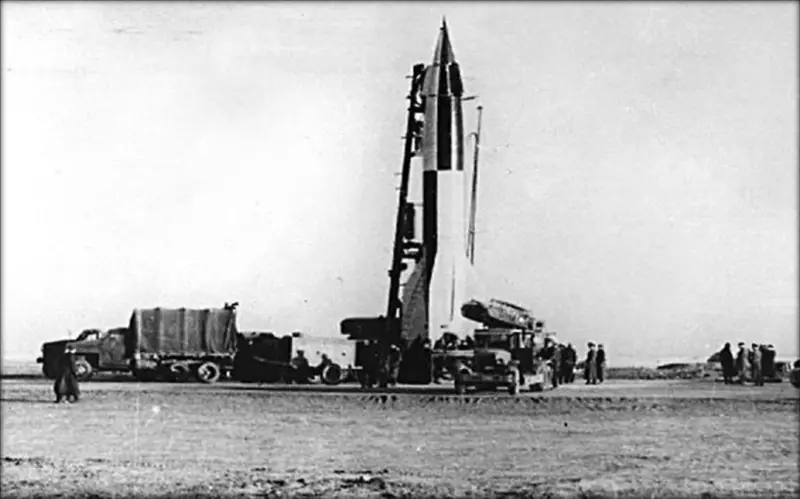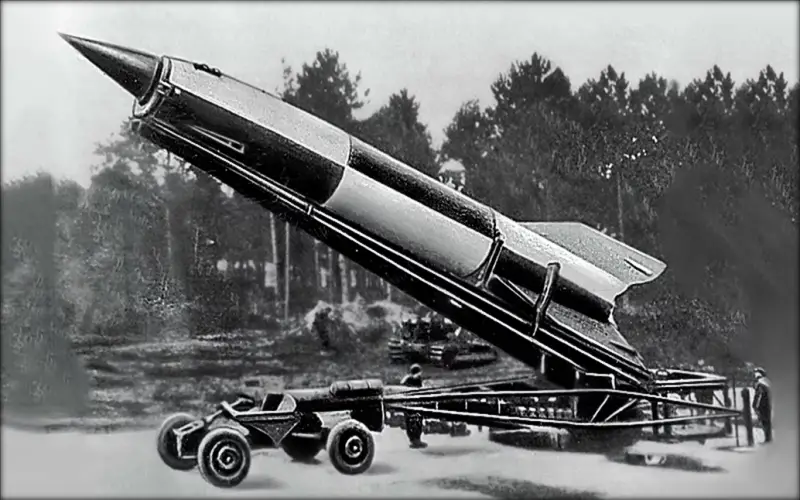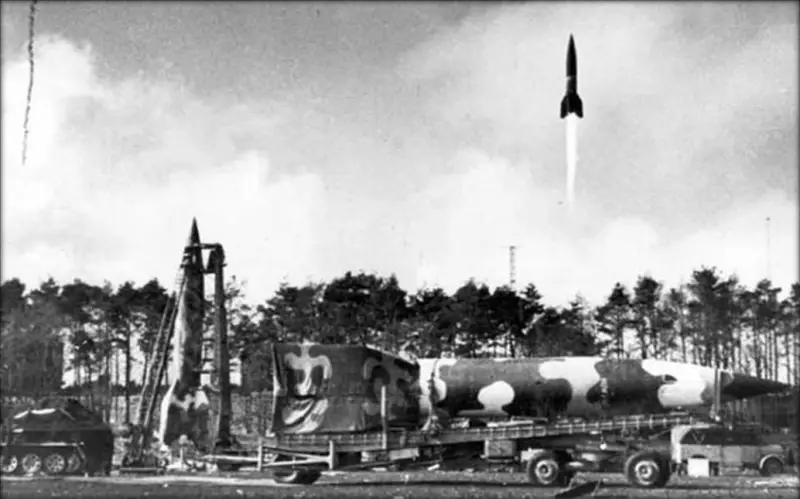The USSR entered the missile age, the first domestic ballistic missile R-1

Before the dust of the battles of the Great Patriotic War had yet settled, geopolitical and ideological contradictions between the former allies in the anti-Hitler coalition led to the beginning of the Cold War.
Taking advantage of their superiority in the field of atomic weapons, the imperialist states, led by the United States of America, which was practically unscathed during the war, began to put pressure on the Soviet Union in order to prevent the spread of communist ideas in the world.
With the expansion of the confrontation, every year the West developed new plans for atomic strikes on the territory of the USSR and its allies - “Totality” (1945), “Pincher” (1946), “Broiler” (1947), “Bushwhacker” (1948) , Crankshaft (1948), Halfmoon (1948), Fleetwood (1948), Cogville (1948), Offtech (1948), Chariotear (1948), and also the famous “Dropshot” (1949).
A huge fleet of Anglo-American strategic bombers, ready at any moment to launch a massive atomic strike, hung over the USSR like a sword of Damocles, forcing it to take desperate measures.
As a response, at the cost of colossal efforts, the Soviet military machine made a huge quantitative and qualitative leap. From 1945 to 1949, the USSR deployed six tank nine mechanized armies, increasing the number of tanks in Europe by one and a half times, rearmed Aviation for first-generation jet aircraft and, most importantly, created his own atomic bomb and intensified extensive work on the rocket program.
Although initially the military-political leadership of the USSR led by Stalin in the post-war period considered missile weapon exclusively as an auxiliary one, against the backdrop of the strengthening of NATO air and naval groups in subsequent years, it became clear that only it, being practically indestructible in all areas of flight in the 1950s–1960s, is capable of ensuring a guaranteed retaliatory strike against the one who carried out the first strike to the aggressor. Therefore, soon, in the mid-1950s during the time of Khrushchev, the leadership of the USSR would nevertheless reconsider its attitude towards missile weapons, placing its bet on them.
This article marks the beginning of a series dedicated to the missile weapons of the USSR during the early Cold War of 1945–1964.
At the dawn of a new era
Having won a decisive victory in World War II, the Soviet Union, and behind it the entire socialist world, preparing for a decisive battle with world imperialism, entered the Cold War.
The most difficult years of the war, marked by the mobilization of all the forces of the Soviet people for the sake of liberating the territories captured by the Nazi invaders and achieving final victory on the Western Front, unfortunately, although they made it possible to defeat the Third Reich and its allies, due to the concentration of the defense industry during the war years on numerical indicators , caused a certain technological lag in the field of advanced weapons from Western countries, which forced the USSR government to take fire measures.
The Soviet Union quickly began work on creating atomic weapons and their carriers. In July 1945, the Tupolev Design Bureau began copying the American B-29 strategic bomber; in August of the same year, the Vystrel group was created, led by Korolev, with the aim of organizing the study of V-2 missiles captured by Soviet troops and assembled from captured parts by comprehensive engineering analysis of their units, as well as organization of trial runs.
Somewhat later, on the instructions of the Minister of Armaments of the USSR Ustinov, to combine the efforts of the Vystrel group with other teams working on missiles, the Nordhausen Institute was created in Germany in 1946, which was engaged in the restoration and translation into Russian of documentation on V-1 missiles and V-2, Wasserfall, Reintochter and Typhoon anti-aircraft missiles, as well as Henschel cruise missiles and Panzerfaust grenade launchers.
Together with German specialists, two special laboratory trains were created, designed for comprehensive testing of missiles during their production, cold and hot bench tests, as well as in the future and combat use of V-2 missiles.
Being equipped with the most complex equipment, each laboratory train consisted of sixty-eight cars for transporting missiles: with a platform with a launch pad for launching missiles, an armored command post, a power plant, a communications center, laboratory cars, workshops, passenger cars for accommodating personnel, a bathhouse, a dining room and even a small cinema.
At the end of the same 1946, it was decided to transfer all work on rocket technology to Soviet territory to the newly created Scientific Research Institute-88, created on the basis of artillery plant number 88 near the Podlipki station near Moscow, where work on assembling V-1947 rockets continued in 2 from German components, and soon the first test launch was carried out on October 18, 1947.
Rocket R-1

Being the first Soviet short-range ballistic missile, the R-1 missile was a copy of the German V-2 missile, produced with some design changes caused by the need to adapt its units to organize its production in the USSR. The first test launch of the R-1 rocket was carried out on October 10, 1948; deliveries to the troops began in 1949.
Performance characteristics
Rocket length - 14,6 m
Rocket diameter – 1,65 m
Launch weight – 13,4 t
Payload weight – 1 kg
Warhead type - non-nuclear high-explosive warhead, inseparable
Flight range – 270 km
Circular probable deviation – 1,5 km
Start of development - 1946
Start of testing - 1948
Date of adoption: 1950
Chief designer - S.P. Korolev.
Forerunners of the Soviet strategic missile forces

Previously formed in 1946 on the basis of the 92nd Guards Mortar Regiment for testing and development of V-2 missiles, the 22nd Special Purpose Brigade was completely re-equipped with R-1949 missiles in 1. With her participation, in the summer of 1950, a tactical exercise was held, the results of which formed the basis of the manual “Combat use of a special-purpose brigade armed with long-range missiles”, for the first time in stories USSR describing the tactics of combat use of missile forces.
According to this manual, missile formations were intended to destroy large military-industrial facilities, important administrative and political centers, communications centers and other strategically important objects with a massive missile strike. Rocket brigades could only be used by decision of the Headquarters of the Supreme High Command, but during the period of hostilities they were promptly subordinate to the commander of the front forces in whose zone they operated.
According to calculations, the missile brigade, consisting of three divisions and occupying a positional area 30–35 km from the front line, had a fire output of 24–36 missiles per day, with the output of a separate division being 8–12 missiles per day.
Unfortunately, the effectiveness of the R-1 missiles left much to be desired: the total time to prepare the missile for launch was about six hours, four fuel components were required for refueling, the refueled missile could not be stored, and in addition, the launch positions were extremely vulnerable to air strikes.
Due to many technical shortcomings, as well as the small number of deployed missile brigades (two for the entire USSR), formations equipped with R-1 missiles, unfortunately, did not have any practical combat value, however, it was their appearance that became the first step of the USSR towards the creation of domestic missiles. strategic troops.
Sources:
1. I. G. Dorgovoz “Missile Forces of the USSR”.
2. I. G. Dorgovoz “Air Shield of the Country of the Soviet Union.”
Information